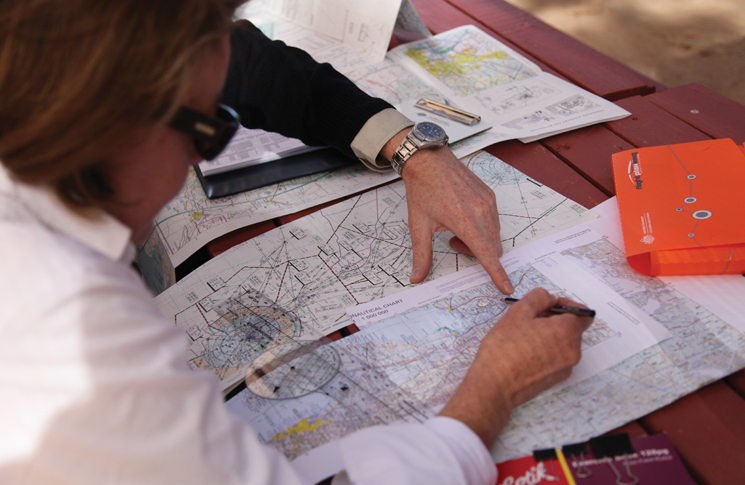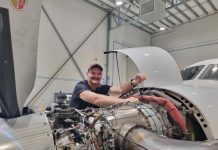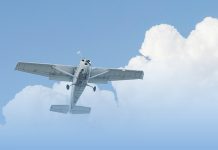Kreisha Ballantyne makes no secret of the fact that she was an ill-equipped student pilot.
Having no pilots in my family, no technical or mechanical knowledge and a personality type more suited to creative learning, I was an instructor’s worst nightmare. My childhood nickname was ‘Kreisha chaos’.
As countless instructors bemoaned my lack of cockpit organisation and my general scatty attitude, I realised early on I needed to change. One of my favourite instructors once told me, ‘to be a pilot, you need to think and act like a pilot’. For me, that was ground-breaking. I set out to learn the art of organisation.
Practical organisation
Aviation comes with an awful lot of stuff. When I was learning to fly, 12 years ago, an instructor quipped, ‘when the weight of the flight bag equals the weight of the pilot, you’re ready to go’.
Swamped by maps, charts, protractors, pencils, ERSA, Country Airstrip Guide, water bottle and whizz wheel in a tiny Beech Skipper with a six-foot instructor, order was essential. While we’ve bypassed most of these accoutrements these days (more on that later), a student pilot is still required to have the heaviest flight bag in the club, until they’re ready to graduate to an EFB for planning; however, that requires organisation:
- Buy a kneeboard for your flight plan and maps. There are so many excellent, practical choices, with sleeves and pockets, that will allow you to keep everything in its place.
- Spend an afternoon learning to fold maps and have them pre-folded for your flight to avoid paper cutting your instructor. Remain aware that on a long navex, the airport you’ll land at will be on the corner of two maps!
- Buy a flight bag that contains lots of pockets and sections (mine was so large I called it ‘flight bag village’) and keep everything in the same place every time you use it.
- As soon as you enter the aircraft, get yourself set up and then place your flight bag on the back seat where you can reach the extra things you need.
- Be sure to access weather, airport information, NOTAMs and alternate airport information on the ground before you depart.
- Do pre-flight calculations that pilots legally need to, such as fuel usage and weight and balance.
- Have your frequencies ready and a script for speaking to the tower/ATC.
- Keep your pen/pencil in your pocket/kneeboard (or, in my case, in my hair) and have a spare—you’re sure to drop it when you need it most.
Organising your aeronautical paraphernalia is an art, but once mastered, it will become a routine. When I flew solo across the country in 2012, my organisational skills became topnotch and, as a consequence of feeling more in control, my confidence grew.
Organisation is initially an art, but with practice it quickly becomes a habit.
Physical organisation
Your body, in combination with your mind, is going to fly the aeroplane. I realise this sounds obvious, but it’s incredible how much neglect the body can take and still function. Self care is an important part of being organised.
- Make sure you are rested before you fly. There are far too many studies detailing the consequences of poor sleep in aviation.
- Be sure to eat and remain hydrated. Dehydration, in particular, can cause a severe case of skill deterioration.
- Be stringent about your medication and if you’re feeling ill, stay on the ground.
- Don’t ever fly after a big night out. The effects of alcohol may last up to 24 hours.
- Use the IMSAFE checklist to cross-reference your physical health with a published set of checks.
IMSAFE is the recommended mnemonic for aircraft pilots to use to assess their fitness to fly:
- illness
- medication
- stress
- alcohol
- fatigue
- emotion.
Mental organisation
With human factors becoming an increasingly large focus in aviation, the importance of mental organisation cannot be overstated. Factors such as stress can have an enormous impact on performance—mental wellbeing is as vital as physical wellbeing.
Emotion and stress are now part of the IMSAFE checklist, for good reason. If it’s not possible to leave your emotional issues on the ground, don’t fly.
The first step in effective stress management is to train yourself to be able to recognise the symptoms that signal its onset before stress levels get too high. Some common symptoms of stress include:
- physical signs: cold, sweaty hands, headache, tension
- behavioural changes: irritability, anger, hurriedness, fixation
- speech patterns: fast, irregular, non-standard phrases, voice tone or loudness.
On presentation of these symptoms, it’s vital to recognise what’s happening and break the circuit. Failure to do so can lead to anxiety and panic. With the onset of any of these signs, take a step back. If you’re able to change your environment, do so—take a walk, call a friend, talk to a colleague. If you are unable to change your environment, change your breathing—a series of deep breaths will calm your body and eventually your mind.
Understanding and acknowledging life’s baggage is a key to stress management. The most basic elements of coping with stress issues are:
- Continuous professional training. Training ensures currency and competence in all standard and emergency operating procedures. If you feel out of depth at work, it’s vital to speak up and seek further training. Lack or loss of confidence is a significant cause of stress.
- Social interaction. It is not prudent to allow personal problems and worries to build up. Communicating them with others is very important as it offers partial relief. Loneliness is a modern epidemic; human beings thrive on social interaction. Isolation may lead to depression and anxiety. Even if you are by nature an introvert, human contact is still vital. Ensure you have at least two people you can rely on to talk things over. If not, consider engaging a therapist or joining a group of like-minded people for social interaction.
- Workload. Do not allow yourself to take on too many tasks and responsibilities (both work and non-work related) that can cause work overload. It is important to learn to say no when asked to do too many tasks.
Modern organisation
Over the last decade, aviation has experienced a technological revolution. Our flight bags have shrunk with the introduction of the EFB, cockpits have become digitalised and learning has become interactive. While doing things the ‘old school’ way is certainly still possible, transitioning to a modern cockpit takes another level of organisation.
The transition from analogue to digital requires time. Be sure you are very familiar with your new primary flight display and multi-function display before flying solo:
- access the user manuals and have a version on your iPad
- watch YouTube videos and those from the manufacturer
- spend some time on the ground really getting to know the new system
- take a right-hand seat flight and just work the new display to familiarise yourself with its features.
For the last year, I have worked with one of Australia’s leading EFB companies. In my role as support advisor, it has become obvious there are still users in GA operating their iPads without confidence or adequate knowledge.
CASA specifies that an EFB utilising aeronautical data that has been supplied by a CASA approved vendor is suitable for use as maps, charts or aeronautical databases and is approved for air navigation purposes. However, the EFB, with GPS functionality, may be used for situational awareness only. It is not an approved navigation system and cannot be used as the primary means of navigation. When transitioning from paper to EFB, be sure to:
- make sure your data is up-to-date
- be sure to always fly with a back-up to the EFB, even if not a CASA requirement. This can be another EFB or paper charts
- ensure your iPad doesn’t overheat in summer, by removing it from its case. If it overheats, place it near the cockpit cooling system, away from the sun.
Organisation is initially an art, but with practice it quickly becomes a habit and thus part of your culture of safety. Being organised will improve your confidence and professionalism and could even save your life.
See the Flight Safety Australia website for these related stories:
- tips on practical organisation and planning: ‘Big trip weather planning’
- a personal account of stress leading to a panic attack: ‘A fine balance’






A great article Kreisha. I too was the first person in my family to fly. Without any background, I didn’t know anything about what was required of me as a student, and had to learn each step the hard way. In the early days, conversations with instructors would start out like this: Instructor: “What’s your ARN?” Me: “My What?” Or: Instructor: “When does your medical expire?” Me: “What medical”. I don’t think I got my first ASIC until 12 months after commencing, and I didn’t discover the more relevant AVID for seveal years – simply because I just didn’t know.
I think it would be very helpful to new students if CASA could produce a typical flow chart or checklist to guide student pilots through the administrative processes associated with learning to fly.
PS: Maybe you should have used Aviation as your expert topic on “Hard Quiz”!
Eric, hi
Thanks for your kind response. I completely concur with your comments regarding the steep learning curve that is GA and think your flow chart idea is fabulous and perhaps worthy of an article in its own right.
Best,
Kreisha
P.S No way could I choose aviation as my Hard Quiz subject – I’ve still got FAR too much to learn :)
Great (and thorough) writing as always, Kreisha
Hi moderator(s), Any particular reason why was my reply sent to Eric not approved ? Thanks, Stjepan
The “E” in the IMSAFE mnemonic stands for Eating, (not Emotion). It is important to have had food before flying and, on a long flight, to carry food so that you do not get hungry en-route.